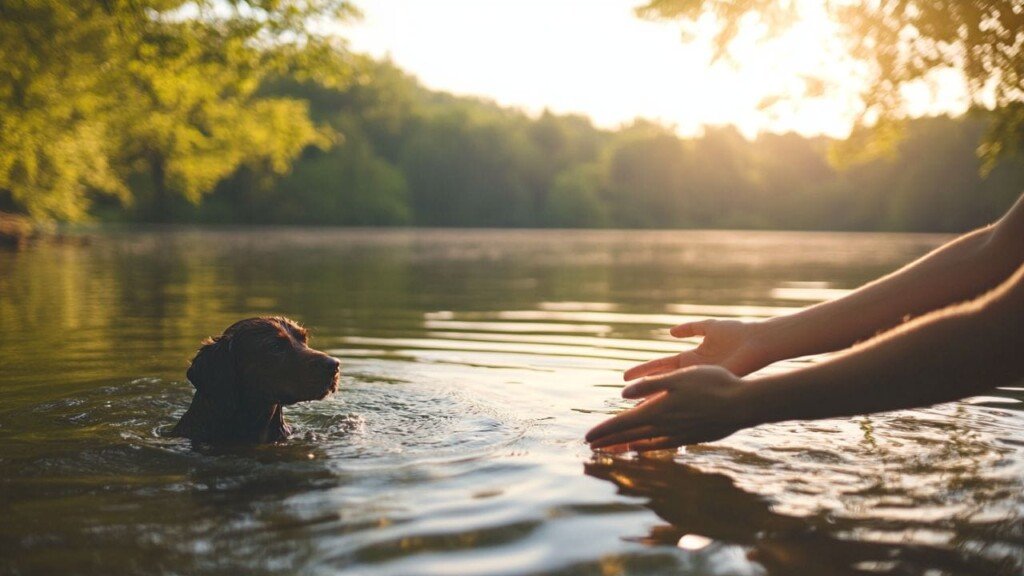Not all dogs are natural-born swimmers, despite the popular belief that they all can instinctively paddle.
Some breeds are more predisposed to enjoying water, while others may be hesitant or even fearful.
It’s crucial to approach water introduction with patience and understanding of your individual dog’s temperament.
Assessing Your Dog’s Readiness
Before diving in, consider your dog’s age, health, and physical condition.
Puppies and senior dogs may need extra care and supervision around water.
Consult with your veterinarian if you have any concerns about your dog’s ability to swim safely.
Choosing the Right Location for First Encounters
Start with shallow, calm waters such as a quiet lake shore or a kiddie pool in your backyard.
Avoid strong currents, waves, or deep water for initial introductions.
Ensure the entry and exit points are easily accessible for your dog.
Want to keep up to date with new animal stories?
Introducing Your Dog to Water Gradually
Begin by simply walking near the water’s edge, allowing your dog to investigate at their own pace.
Use positive reinforcement, offering treats and praise for calm behavior near the water.
Never force your dog into the water; let them build confidence through positive experiences.
Using Toys and Play to Encourage Water Interaction
Bring your dog’s favorite toys to the water’s edge to create positive associations.
Toss a floating toy a short distance into shallow water to entice your dog to retrieve it.
Gradually increase the distance as your dog becomes more comfortable entering the water.
Teaching the Basics of Paddling
Once your dog is comfortable in shallow water, support their midsection as they start to paddle.
Gently guide them into slightly deeper water while maintaining support.
Encourage them with praise and let them return to shallower water frequently to build confidence.
Introducing Your Dog to Swimming Pools
If introducing your dog to a pool, start at the shallow end or steps.
Teach your dog where the exits are by guiding them to the steps or ramp multiple times.
Consider using a dog life jacket for added safety, especially in the early stages.
Recognizing Signs of Stress or Fatigue
Watch for signs of anxiety such as whining, shaking, or attempting to climb on you.
Be aware that even strong swimmers can tire quickly, especially in cold water.
End the session on a positive note before your dog becomes overly tired or stressed.

Ensuring Water Safety
Never leave your dog unsupervised around water, even if they’re a strong swimmer.
Be cautious of water temperature; dogs can get hypothermia in cold water.
Watch out for hidden dangers like strong currents, underwater debris, or wildlife.
Investing in Proper Safety Equipment
Consider purchasing a well-fitting dog life jacket, especially for boat trips or swimming in open water.
Choose brightly colored gear to make your dog easily visible in the water.
Ensure all safety equipment is comfortable and doesn’t restrict your dog’s movement.
Establishing Clear Commands for Water Safety
Teach your dog commands like “come,” “stay,” and “out” specifically for use around water.
Practice these commands on dry land before using them in aquatic situations.
Reinforce these commands consistently to ensure your dog’s safety in and around water.
Maintaining Hygiene After Swimming
Rinse your dog with fresh water after swimming, especially in chlorinated pools or salt water.
Pay special attention to cleaning and drying your dog’s ears to prevent infections.
Check for any cuts or abrasions that may have occurred during the swim session.

Building Endurance and Confidence Over Time
Gradually increase the duration and complexity of swim sessions as your dog becomes more comfortable.
Introduce new water environments slowly, always prioritizing safety and positive experiences.
Celebrate your dog’s progress and continue to make water activities fun and rewarding.
Addressing Common Challenges
If your dog is fearful, take extra time to build positive associations with water.
For over-enthusiastic dogs, teach impulse control around water to prevent accidents.
Seek professional help if you encounter persistent issues or fears that you can’t overcome.
Conclusion: Diving into a World of Aquatic Fun
Introducing your dog to water and swimming can open up a world of enjoyable activities for both of you.
Remember that every dog is unique, and the process may take time and patience.
By following these guidelines and prioritizing safety, you can help your furry friend become a confident and happy swimmer.
Share this guide to help fellow dog owners safely introduce their pets to the joys of swimming! Whether you have a water-loving Labrador or a hesitant Chihuahua, these tips can help make water activities safe and fun for all dogs.
SHARE now with your friends!


